December 29th, 2007
Here’s an updated picture of my 75G tank. As you can see, it has really started to fill in, and besides needing a trim, I’m pretty happy with how it’s looking. The Utricularia graminfolia in the foreground has started growing over and on top of itself, and the Ludwigia and Limnophilia aromatica on the left/middle have started to layer themselves and bush out quite nicely.
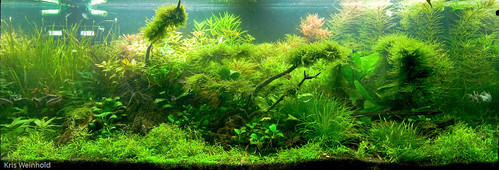
I’ve still got a little bit of black-brush-algae on some of the rocks and wood, but it’s being kept in check by my algae crew, and actually gives the tank a bit of a natural flare. (Or that’s the story I’m going with for now.) The Blyxa japonica looks as good as it ever has since I’ve been growing it, and the Blyxa aubertii is actually starting to look a tad nicer as well, since I moved it from my 40G. All-in-all, I’m looking forward to shaping this scape slightly with some trimming, and fine tuning, but the initial work is done. I’d love to hear your comments/critiques!
Posted in 75G Tank Log | 4 Comments »
December 17th, 2007
After much consideration, I finally decided upon this Pelvicachromis pulcher ‘Super Red’ pair to occupy the other side of my 75G from the Nannochromis nudiceps. These fish are a color variation of your common P. pulcher kribensis that are far redder than the normal variety.

Purchased from SCALES in Silver Spring, MD, I was informed that this pair had already spawned in store, yielding a small group of fry that were taken home by an employee. Already in my 75G, I witnessed plenty of fin flashing and body wiggling between the pair. Even weirder, I’ve seen the female display the same motions toward the male N. nudiceps. Clearly this female is both confused, and ready for motherhood!
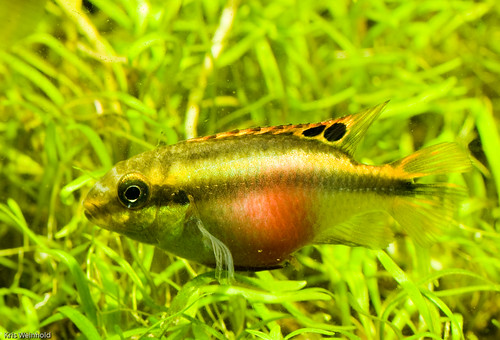
The female is by far the more beautiful fish of the pair. Her belly is a ripe red color, with some really nice spots on her fins. The yellow is also quite intense. The female kribensis has a very interesting body shape, as her belly seems slightly out of proportion from the rest of her. Hopefully I’ll be able to report a successful spawning sometime soon!
Posted in 75G Tank Log, Fish Profiles | 5 Comments »
December 8th, 2007
The Utricularia graminifolia is starting to grow in in the 75G tank. It’s still not really that full, but you can start seeing some little leaves pop up from the aquasoil substrate. My theory is that this plant takes longer than others to get going because it requires a more mature tank with more microorganisms to get caught in its bladders. Of course, I can’t say that I’ve grown it predictably enough to have it fully understood at this point.
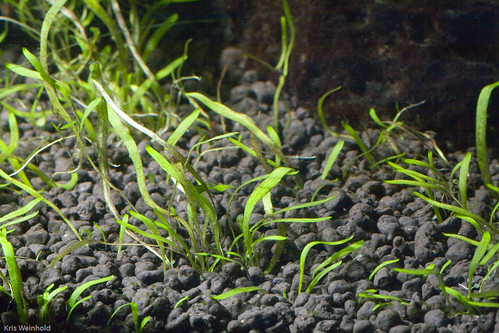
What I know is that that once I start seeing “trailers” like the ones below, that that plant is well on its way to filling in. I’ve also had a number of “trailers” growing up into the water column, making the foreground look too tall and shabby, but I’ve gradually cut those off and replanted them in the bare areas to try and get them going.
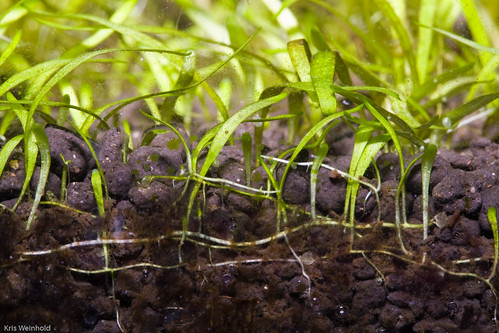
Additionally, the Nannochromis nudiceps seem to have gotten over their digging fascination, so they’re no longer pulling up, or covering up, the Utricularia graminifolia directly in front of their “underground lair.”
Posted in 75G Tank Log, Plant Profiles | Comments Off on Utricularia graminifolia
December 6th, 2007
After nearly 6 weeks in 20L, I finally returned my four Red Lizard Catfish, Hemiloricaria sp. ‘Red’ (L10a), to the 75G tank. I’ve been leaving them out for two reasons: I wanted the water chemistry in the 75G to stabilize, and I wanted the Utricularia graminfolia to get partially established before I reintroduced them to the tank.

These pale reddish catfish are quite lazy fish in my tanks. They spend a large deal of their time lounging on the substrate or hardscape. It would be fantastic if they actually ate some of the black-brush-algae they’re laying on in the pictures. Fortunately, the Amano shrimp are slowly mowing that down.

Despite their less-than-ideal appetite for algae, they stay small, and they’re colorful, so I enjoy having them in my tank. They’ve already seemed to settle back into their larger home. The 75G is quickly turning into a catfish tank with all of the corydoras, Ancistrus sp. L279, and these guys.
Posted in 75G Tank Log, Catfish | 1 Comment »
November 29th, 2007
It’s been a tad longer than 5 weeks since I first setup my 75G. The moss on the wood is really bushing out right now, the Utricularia in the foreground is starting to establish itself, and nearly all of the other plants are coming into their own.
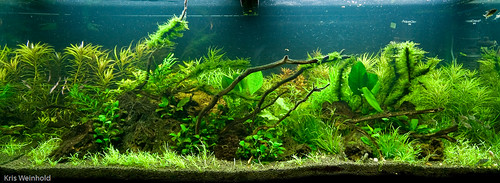
I the P. stellata ‘broad-leaf’ on the left side still is a few trimmings away from fully filling in, as is the P. yatabeanus, but everything is well on its way. The Blyxa japonica is looking fantastic, despite a lot of upheaval of the substrate surrounding it thanks to my Nannachromis nudiceps. They still haven’t spawned to the best of my knowledge, so perhaps they’re not going to, but that doesn’t stop them from digging. I still haven’t decided on any other tankmates, but I have some Amano shrimp coming in a GWAPA group order, and I’m eyeing the Nigerian Red Kribs.
I’d love to hear all comments and critique so far. Here’s a question: Do you think I ought to put moss on more of the wood, particularly the center-most piece, or do you like it bare?
Posted in 75G Tank Log | 5 Comments »
November 18th, 2007
At both the Catfish Convention and the Aquafest auction, I picked up a bag of Ancistrus sp. L279 dwarf bushy-nosed plecos. After keeping them for other a year, I think this species is a fantastic match for a planted aquarium. They max out in length around 4 inches so they’re not going to inadvertently uproot plants from their size. Mine are not shy, so I see them on wood or lounging on open substrate, and they’re fairly active algae eaters. Plus, they’re very attractive fish with white markings on the tips of their tail, and many have very nice spots on their body. I’m guessing that the spots are a gender distinction because some of mine have very pronounced ones, and others not so much.

I don’t have any with huge sections of tentacles/growths on their snout, but they do have some small barbels. I’m hoping that as my latest batch grows up, they’ll develop these further. I’ve seen this species posted on Aquabid, sometimes called Ancistrus sp. ‘Huaca Mayo,’ so if you come across this listing, give them a try — they’re a great little ancistrus!
Posted in 54G Tank Log, 75G Tank Log, Catfish, Fish Profiles | 1 Comment »
November 16th, 2007
I generally haven’t done many aquascapes using moss as a key feature. There’s not any reason in particular, besides the fact that it’s sometimes more work to keep it looking nice and algae-free, but basically, I’ve just done differently styled scapes. (The same is true for the classic Amano riccia scape — note to self, do a riccia scape.) So, for this reason, I’m pretty happy to see the moss in my 75G tank starting to attach itself and cover the manzanita wood I tied it to.
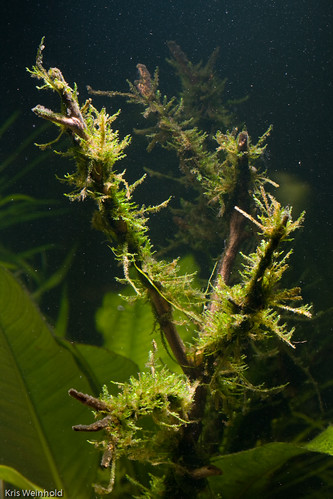
You can see new growth by the brighter green fronds on the tips of the moss. Now, I’ve got to make the decision whether to go for a bushy effect, or to trim it tight and close to the wood to achieve more of an astroturf’d wood look. I think I’m leaning toward the bushy look for now, but I suspect that may change if piece start disattaching and infiltrating my anubias. In any case, trimming moss is a bit of a chore, as you don’t want the pieces you cut off going everywhere in your tank.
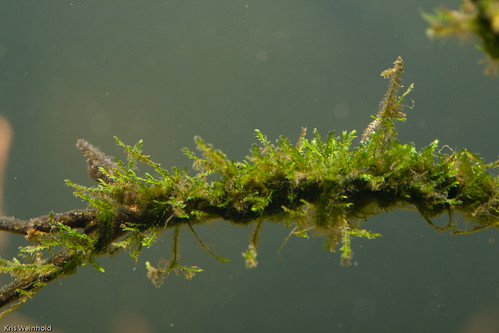
A common technique to avoid this is to trim while siphoning during a water change. Hold the siphon right above where you’re trimming, and those pieces should get sucked right out of the tank. I’m definitely not an expert at grooming these mosses, so if anyone has some other tips/suggestions, please comment.
Posted in 75G Tank Log | Comments Off on 75G – Mossy Wood
November 13th, 2007
I decided to take a few snapshots of the fauna in my 75G. As I mentioned a couple weeks ago, all of fish in this tanks were obtained in the auction from Aquafest. I haven’t had any losses, and all seem to be quite happy settling into their new surroundings.

There are 18 Corydoras paleatus in the tank that are constantly scurrying around the tan. They’re very social creatures zigging and zagging throughout the plants with at least one other companion in tow. Some lucky (or unlucky) plump females draw a crowd of male suitors up and down the glass. No eggs that I’ve seen yet.

The pair of Nannochromis nudiceps have taken up residence underneath two rocks on the right side of the tank. I’m a little bothered by their persistent efforts to dig up powersand from the bottle of the tank, and litter the large ugly white pumice stone across the top of the prettier aquasoil, but if they end up spawning I’ll forgive them.

Lately, they’ve decided to start covering the top of the rocks with aquasoil too. I hope their little “underground lair” doesn’t collapse on top of them!

And of course, there’s a huge population of cherry shrimp in the tank. I dumped in about 200 from the pond before the weather turned cold. I’m sure a few made a nice snack for the cichlids, but there’s still a ton. I did a quick trim of some plants, and I had to chuckle as 5-6 shrimp abandoned ship after I trimmed a single stem that they were occupying, and it began floating upward.
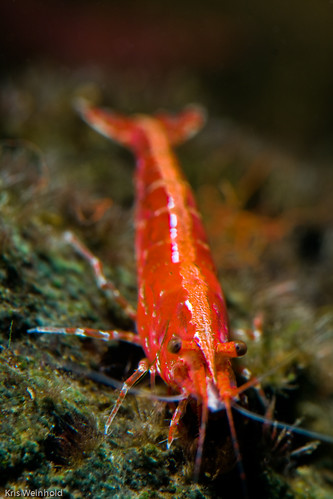
Hopefully, the shrimp will clear up the bit of algae that still remains on the rocks and wood. The only other inhabitants are some nerite snails, and 5-6 dwarf Ancistrus sp. L279 “Huaco Mayo.” I’ll try to profile those on their own at a later time.
Posted in 75G Tank Log | 1 Comment »
November 11th, 2007
It’s been 3 weeks since I rescaped my 75G tank, and things are finally starting to grow in a little bit. After getting home from my recent trip to Williamsburg, VA, this tank looked pretty terrible. The water was yellow in color, and algae had gotten more than a small grip on the hardscape. Over the last week, with water changes, Seachem Excel, and one use of flocculate to help the filter clear the water, it’s finally starting to look halfway decent.
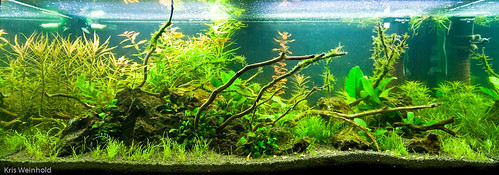
The Utricularia graminfolia is growing well, even though it’s getting much taller than I usually see it. Hopefully that’s just a temporary thing. I still have some algae on the manzanita and rocks, but it’s coming under control. And, if you haven’t noticed already, my attempt to do a stem-free tank isn’t going very well, as I’ve got plenty of stems in there. I think that I may end up keeping them in after all. Or at least until the next time I get tired of trimming.
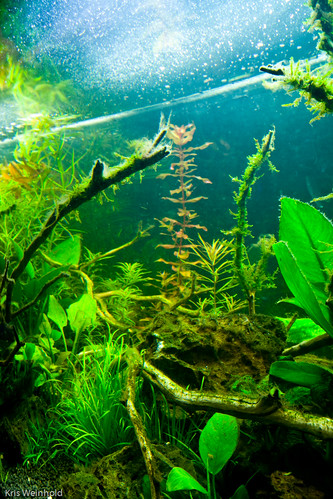
Posted in 75G Tank Log | 2 Comments »
November 3rd, 2007
I finally did it! I removed all of the Soilmaster Select from my 75G, and went with Aquasoil/powersand using the manzanita I ordered months ago. This is really the first aquascape I’ve down with manzanita wood. Well, I suppose that’s not entirely true since Jeff and I aquascaped the AquaFest demonstration tank with it about 4 hours before I setup this tank, but I don’t think that counts.
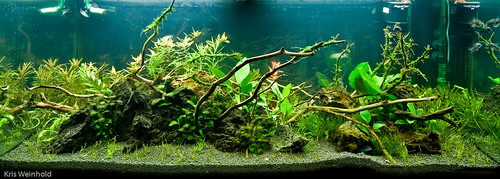
A few goals for this tank are to actually get a good Utricularia graminfolia foreground growing well, have better circulation (and less algae), and perhaps fewer stems than I had before. So far, I’ve got quite a few crypts in the tank with C. affinis, C. wendtii ‘Dewitt,’ C. wendtii ‘Green Gecko,’ C. willisii x lucens ‘green,’ and C. moehlmannii. I’ve also got my share of anubias with A. sp. ‘garbon,’ A. heterophylla, A. lanceolata, A. barteri var. ‘nana,’ A. sp. ‘Eyes’ and A. sp. ‘Gasser.’ I do still have some stems in here consisting of Pogostemon stellata ‘broad-leaf’, ‘needle leaf’, and regular. Plus, P. yatabeanus, Ludwigia arculata x repens, and Rotala macrandra.
I’m still figuring out what species of fish I want in this tank. So, far, the three bags of fish I got at Aquafest are in here, so some Nannochromis nudiceps, Ancistrus sp. L279 “Huaco Mayo,” and Corydoras Paleatus. I’m thinking about getting some other West African dwarf cichlids, but I haven’t decided on the exact species or color morph yet.
It still has a lot of growing in to do, but I’d love to hear some initial feedback.
Posted in 75G Tank Log | 2 Comments »


















